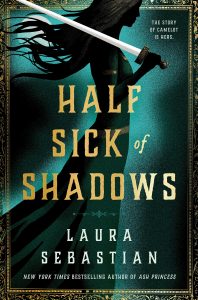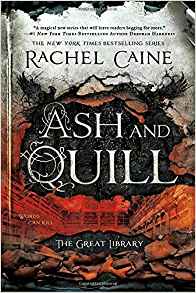Maya C. James Reviews Half Sick of Shadows by Laura Sebastian
 Half Sick of Shadows, Laura Sebastian (Ace 978-0-593-200513, $27.00, 448pp, hc) July 2021.
Half Sick of Shadows, Laura Sebastian (Ace 978-0-593-200513, $27.00, 448pp, hc) July 2021.
Elaine is surrounded by heroes, and she knows how each of them will fall: Morgana the sorceress, Lancelot the knight, Gwen the queen, and Arthur the king; all powerful pieces on a chess board waiting to be toppled by their own doing. Despite her great power of Sight, there is nothing Elaine can do but gaze into the future and hope her loved ones make the right choices. That is, until she begins to question her own fate and worth.
Half Sick of Shadows is a feminist retelling of Elaine, Lady of Shalott; the infamously depressed woman first written about in Alfred, Lord Tennyson’s poem ‘‘Lady of Shalott’’. Starting with her beginnings as a shy, bullied girl, to her rise as a wise woman and advisor to the once and future king, we witness Elaine’s painful transformation from a shell of a girl into a powerful oracle ready to destroy fate itself.
For those unfamiliar, ‘‘Lady of Shalott’’ is a tragic tale of a woman isolated in a tower, forbidden to look down at Camelot. Here, she sits by a loom, and only sees the world passing by in shadows through a mirror on her wall. Most notably, she utters the words ‘‘I am half sick of shadows’’ midway through the poem – the shadows of people moving throughout the world on her mirror. Elaine’s tragic end is one you’d expect from a poem of that time. She is ultimately punished for her desire to see more of the world beyond her prison.
Sebastian embarks on an enormous undertaking to give Elaine backstory, personality, and vices, among other details. Half Sick of Shadows is the kind of book that is seemingly built upon meticulous research and editing, including Sebastian’s commitment to interrogating the feminist elements of the original poem. Fortunately, like the two versions of Tennyson’s poem (one from 1833 and the other finished in 1842), endings are never quite set in stone. What could have easily devolved into a grimdark fantasy instead becomes an intense journey of waiting to see when, and if Elaine’s visions come true, or if she can do anything to change fate. Most notably, she begins to wonder if her future is valued as much as Arthur’s and those of many of the other men and women in her life.
It was a risky choice to make an oracle the main character – if they can see the future, what do they have to fear, or change? Even during Elaine’s life in Avalon, before she crosses the threshold into the dangerous world of court politics, she is burdened by prophecies ending in horror and pain for all her friends. As a seer, she spends most of her days by her loom, threading blank strings together until visions overtake her. Rarely can she ever make a difference, and telling her friends of these prophecies only makes matters worse.
Despite her seemingly mundane role, Elaine is an interesting character, one who is emotionally pulled and ripped apart by the people that love her and use her to get the answers they need. Elaine is not the hero of the novel, not when placed beside Arthur and Lancelot, and other better-known characters of Arthurian myth. The hero’s journey is a straightforward one for them, but for Elaine, there are far more complications, and tougher choices. She, Morgana, and Gwen often sacrifice their own happiness and destiny for the hope that Arthur can save them all. Sebastian keeps an intense pace throughout the novel, despite what appears to be a predictable plot. Elaine’s dreams, written in past, present, and future tense, are merely possibilities – terrifying, deadly possibilities, some of which are more certain and painful than others.
The atmosphere of the novel is evenly maintained, with Sebastian’s romantic, lyrical style adding a nice layer of depth to the original Arthurian tale. The misty shores of Avalon brim with intrigue and fay magic, while the halls of Camelot become increasingly stuffy and restrictive for the cast of women in the novel.
Elaine can be frustrating; she’s not quite as feminist as a reader might hope for her to be early on, and despite the power she does have, she seemingly can’t grow beyond the shadows of her mentors, friends, and childhood bullies. Her trauma informs many of her choices, too. Raised under an emotionally absent mother whose poisons masquerades as cures, she eventually learns that the broken people in her life gave her kernels of truth – notably her mother’s ominous warning that powerful men will use her, and when they realize nothing they do makes a difference, they’ll blame her, and destroy her. Morgana and Gwen are more certain of their desires, and it takes some patience to watch Elaine grow comfortable and gracefully into her own self when juxtaposed with these confident characters. It’s hard not to want Elaine to succeed, however. She’s written as a genuinely shy, flawed young woman learning to outgrow burdens placed upon her.
Retellings need memorable elements to distinguish them from their source tales. In the case of Half Sick of Shadows, Sebastian offers a more sensory, realistic experience – Morgana is no longer a conniving sorceress, but a young woman who chooses power over a life of scorn and restriction. Gwen is more than just an unfaithful lover of Arthur, but a woman with her own magic and land to rule. And Elaine is more than just an advisor with the gift of Sight, or a hopeless girl who should have stayed locked in her tower; she’s a young woman that will fight for her own future. No matter the cost.
Maya C. James is a graduate of the Lannan Fellows Program at Georgetown University, and full-time student at Harvard Divinity School. Her work has appeared in Star*Line, Strange Horizons, FIYAH, Soar: For Harriet, and Georgetown University’s Berkley Center Blog, among others. She was recently long listed for the Stockholm Writers Festival First Pages Prize (2019), and featured on a feminist speculative poetry panel at the 2019 CD Wright Women Writer’s Conference. Her work focuses primarily on Afrofuturism, and imagining sustainable futures for at-risk communities. You can find more of her work here, and follow her on Twitter: @mayawritesgood.
This review and more like it in the September 2021 issue of Locus.
 While you are here, please take a moment to support Locus with a one-time or recurring donation. We rely on reader donations to keep the magazine and site going, and would like to keep the site paywall free, but WE NEED YOUR FINANCIAL SUPPORT to continue quality coverage of the science fiction and fantasy field.
While you are here, please take a moment to support Locus with a one-time or recurring donation. We rely on reader donations to keep the magazine and site going, and would like to keep the site paywall free, but WE NEED YOUR FINANCIAL SUPPORT to continue quality coverage of the science fiction and fantasy field.
©Locus Magazine. Copyrighted material may not be republished without permission of LSFF.






